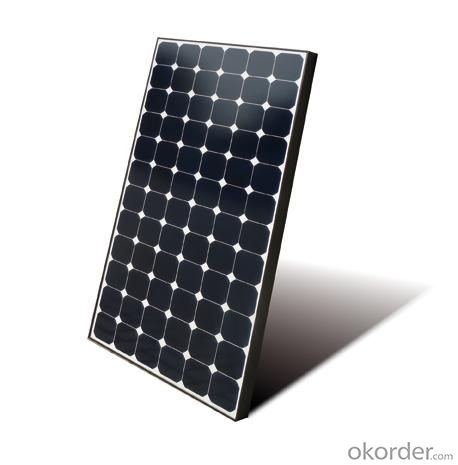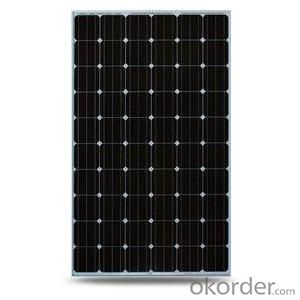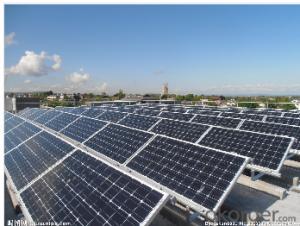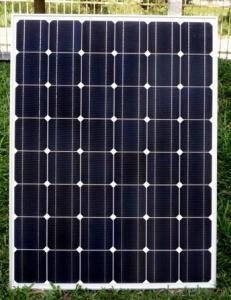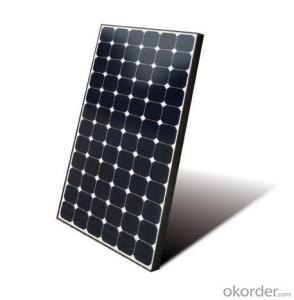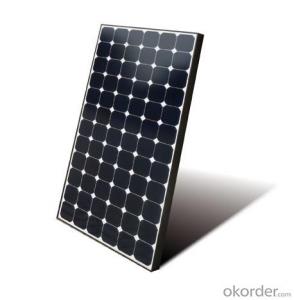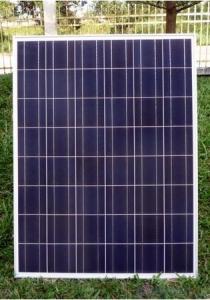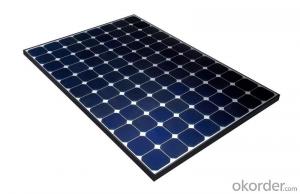Wet Solar Panels - CNBM Poly 180W Solar Panel with TUV UL CE Certificate for Residential
- Loading Port:
- Shanghai
- Payment Terms:
- TT OR LC
- Min Order Qty:
- 100 watt
- Supply Capability:
- 1000 watt/month
OKorder Service Pledge
OKorder Financial Service
You Might Also Like
Specification
CNBM Poly 180W Solar Panel with TUV UL CE Certificate For Residential
Introduction
Each module is rated by its DC output power under standard test conditions, and typically ranges from 100 to 365 watts. The efficiency of a module determines the area of a module given the same rated output – an 8% efficient 230 watt module will have twice the area of a 16% efficient 230 watt module. There are a few solar panels available that are exceeding 19% efficiency. A single solar module can produce only a limited amount of power; most installations contain multiple modules. A photovoltaic system typically includes a panel or an array of solar modules, a solar inverter, and sometimes a battery and/or solar tracker and interconnection wiring.
Solar modules use light energy (photons) from the sun to generate electricity through the photovoltaic effect. The majority of modules use wafer-based crystalline silicon cells or thin-film cells based on cadmium telluride or silicon. The structural (load carrying) member of a module can either be the top layer or the back layer. Cells must also be protected from mechanical damage and moisture. Most solar modules are rigid, but semi-flexible ones are available, based on thin-film cells.
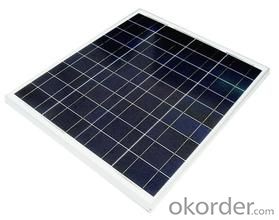
Suggested application
Home lighting business lighting,
Garden lighting, pavement lighting
Farmer household lighting
Decorative water pump
Traffic signal lighting
Industry area
Business area
Solar Power Plant
Product feature
Modules are made of Monocrystalline or Polycrystalline Silicon cell.
Materials and color of the solar panel frame: Clear anodized aluminum alloy type 6063T5 Universal frame; Silver-white color;
The output connection gathers the coupling: Selects conforms to the IEC-612615; 2005, class II, IEC61730 international standard; Airtight waterproofing binding clamp;
Module seal structure: The surface is thick, the high diaphanous rate armored glass with solar cell board special-purpose 3.2mm becomes after the high temperature lamination craft. The back selects has waterproof and anti- aged performance fine TPT materials. The entire block battery board has, the waterproofing, the anti- aging airtight and so on the fine performance;
Power tolerance: +/-3%
Packaging
International standard cartons (according to the requirements of customers)
- Q: How do solar panels affect the overall energy security of a building?
- Solar panels can greatly enhance the overall energy security of a building. By harnessing the sun's energy, solar panels provide a reliable and renewable source of electricity. This reduces dependence on traditional fossil fuels and the associated risks of price fluctuations, supply disruptions, and geopolitical tensions. With solar panels, buildings can generate their own clean energy, ensuring a more stable and self-sufficient power supply, which ultimately contributes to a stronger energy security profile.
- Q: Can solar panels be used during a power outage?
- No, solar panels cannot be used during a power outage unless there is a battery backup system in place.
- Q: I think that solar panels are the future and i think that the conventional way of generating electricity is going to be replaced by solar panels. I would like to be part of this industry as an entrepreneur but i do not know how to since i do not have a technical background. I would like to sell solar panels to consumers and to business. Should I start a manufacturing company that manufactures solar panels? Should I buy solar panels from manufactures and sell them to consumers? What should I do?
- HEAR IS A WAY, BY CLICKING THE LINKS $$GET PAID $$GET PAID $200+EURO 200 INSTANT $$ $$SINGUP BONUS $$ GET PAID BY CLICKING BELOW FOLLOW THE INSTRUCTIONSFIRST CLICK THE LINK ONE AND REGISTER YOUR SELF, AND THEN CLICK THE LINK TWO AND REGISTER YOUR SELF CLICK AND GET THE LINKS:
- Q: Hi.How efficienent are solar panels? I mean, suppose we install a kw panel.. Wil it produce 5kw in 5 hours of good sun light?Or like if its 80 percent efficient, wil it produce 4kw and so on.Also, do the chinese solar panels give the same results as compared with panels from other countries?I live in india, so we get plenty of sunlight during the day.Thanks
- Efficiency of photovoltaic panels usually describes the ratio between the energy of the sunlight falling onto the panels and the electric energy you get out. This number is, for commercially available panels today, usually in the range of 2...9 %. What you are asking is something else. The power from the panel depends on the light falling on it. A panel rated for kw peak will deliver that kw under a clear sky, with the sun orthogonally above the panel. For a fixed mounted panel, that is true (at most) for two days every year at noon. At any other time, the output is less. Therefore (at least for the area I live in), some people build databases (and Excel tools) in which the various variables are considered: - inclination of the panel - orientation of the panel - average sunshine duration during a year Plugging in these numbers, I get theoretically for my roof an electricity output of just over 000 kWh/year per installed kWpeak of collector power. If you set up a tracking panel (following the sun), the energy output of the panel will be higher, but so will be the cost for the mounting and the area needed to set up the system.
- Q: can u use a light bulb instead of the sun to power a solar panel
- Solar Powered Light Bulbs
- Q: Can solar panels be installed on wearable devices?
- Yes, solar panels can be installed on wearable devices. However, due to the limited surface area available on wearables, the amount of energy generated may be relatively low compared to larger solar installations. Additionally, the efficiency of such panels may vary based on the device's orientation to the sun. Nonetheless, incorporating solar panels on wearables can contribute to extending battery life and enhancing their overall sustainability.
- Q: right now, you would need a suitable number of solar panels just to power house that can take up a lot of real estate. so my question is, is it feasible to create something that absorbs more of the suns energy like a magnet it would suck it up. the point of doing this would be so that we wouldnt need so much space so many panels just to power home for example.i hope thats coherent.
- No, it's not possible to make solar panels that suck in photons like a magnet. In current physics, the only way to do that would be to make a near-black-hole-like structure that sucks photons in due to its high gravity. Not only would that be prohibitively expensive and currently technologically impossible, it would destroy its surrounding area. Edit: idlenesss - My whole point is that increasing the photons-per-area is currently impossible, and that's what the question was about.
- Q: i really love the idea of solar and want to start out small, so i'm new to this.I plan on getting an 85w panel to charge my laptop. what other equipment is needed to accomplish this?would i need to get a battery or does the solar panel hook directly to the laptop. Does one end just lead to a conventional outlet similar to a wall outlet?could someone please give me a detailed explanation with options about this? i would greatly appreciate it.
- humm..... .need HUGE solar panel (alot) 2. wires 3. aligato clips . put the panels on the roof 2. use the aligator clip to clip the wire from the panel to the bars of the pluger of the comp. charger 3.tada mark me best:)
- Q: What is the cost of installing solar panels?
- The cost of installing solar panels can vary depending on various factors such as the size of the installation, location, type of panels, and additional equipment needed. On average, a residential solar panel system can cost anywhere between $10,000 to $30,000 or more. However, it's important to note that there may be potential tax incentives, rebates, and financing options available, which can help offset the upfront costs and make solar panel installations more affordable.
- Q: Can solar panels be installed on a pergola or awning?
- Yes, solar panels can be installed on a pergola or awning. In fact, these structures can provide an ideal platform for solar panel installation, as they offer ample sunlight exposure and an elevated position that maximizes energy production. Installing solar panels on a pergola or awning can not only generate clean and renewable energy but also provide shade and protection from the elements.
Send your message to us
Wet Solar Panels - CNBM Poly 180W Solar Panel with TUV UL CE Certificate for Residential
- Loading Port:
- Shanghai
- Payment Terms:
- TT OR LC
- Min Order Qty:
- 100 watt
- Supply Capability:
- 1000 watt/month
OKorder Service Pledge
OKorder Financial Service
Similar products
Hot products
Hot Searches
Related keywords


